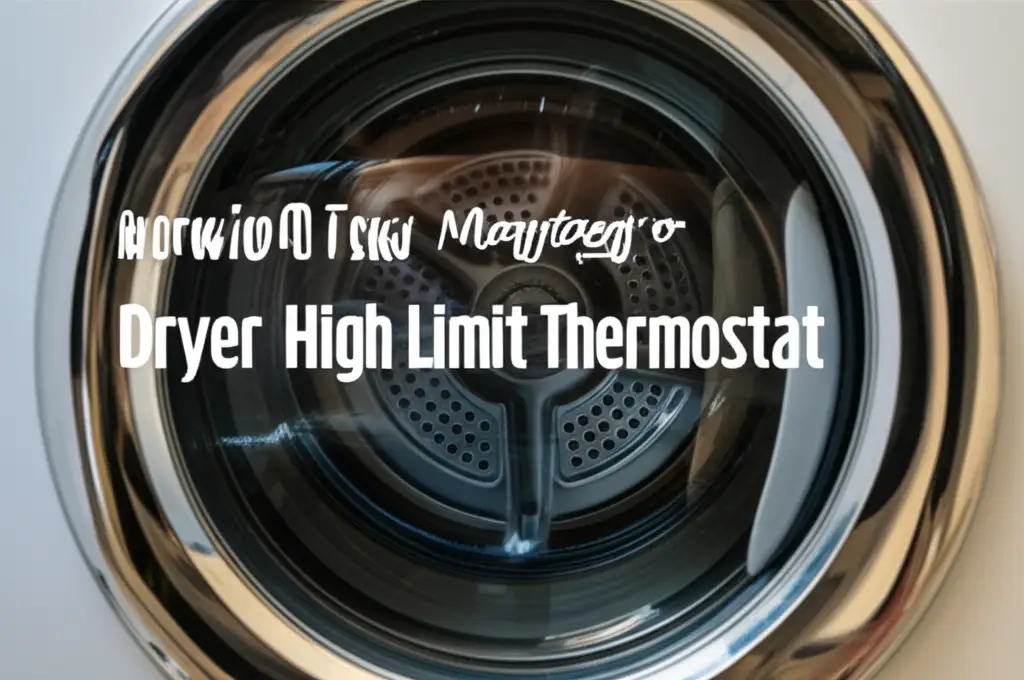· Todd Martin · Home Appliance Repair · 19 min read
How To Test Maytag Dryer High Limit Thermostat

Testing Your Maytag Dryer’s High Limit Thermostat
Is your Maytag dryer not heating up, or perhaps it’s getting too hot and shutting off? These issues often point to a problem with the high limit thermostat. This tiny but vital component keeps your dryer safe by preventing overheating. Knowing how to test your Maytag dryer high limit thermostat helps diagnose common heating issues. It can save you time and money on professional repairs.
I remember my own Maytag dryer suddenly stopped getting hot. Clothes were damp even after long cycles. It was frustrating. I started researching and realized the high limit thermostat might be the culprit. Understanding its function and how to test it made all the difference. This guide provides a clear, step-by-step process for troubleshooting this part. We will cover the tools you need and safety precautions. You will also learn how to interpret your test results.
Takeaway
Testing your Maytag dryer’s high limit thermostat involves specific steps for accuracy:
- Always disconnect power before beginning any work.
- Locate the thermostat on the blower housing or heating element assembly.
- Use a multimeter to perform a continuity test.
- A functioning thermostat shows continuity (a reading near zero ohms).
- No continuity indicates a faulty thermostat that needs replacement.
Answer to Main Query
To test a Maytag dryer high limit thermostat, first disconnect power to the dryer. Locate the thermostat, usually near the heating element or blower housing. Use a multimeter set to ohms (Ω) to test for continuity across its terminals. A good thermostat will show a reading of close to zero ohms, indicating a closed circuit. No reading means the thermostat is open and faulty.
Understanding the High Limit Thermostat in Your Dryer
The high limit thermostat is an important safety device in your Maytag dryer. Its main job is to monitor the temperature inside the dryer drum. If the temperature goes above a safe level, this thermostat opens its circuit. This action immediately cuts power to the heating element. It prevents the dryer from overheating. Overheating can damage clothes or even cause a fire.
This component acts as a safeguard. It ensures your dryer operates within safe temperature limits. A faulty high limit thermostat can lead to several problems. Your dryer might not heat at all, or it could get dangerously hot. It may also shut off unexpectedly during a cycle. Recognizing these symptoms helps you narrow down the issue. Knowing what the thermostat does is the first step in troubleshooting.
What is a High Limit Thermostat?
A high limit thermostat is a thermal cut-off switch. It monitors the temperature in a specific area of the dryer. When the temperature reaches a pre-set maximum, the internal bimetallic disc snaps open. This breaks the electrical circuit to the heating element. The heating element stops producing heat immediately. This design protects your appliance. It also protects your home from fire hazards.
This thermostat is different from the operating thermostat. The operating thermostat controls the regular drying temperature. The high limit thermostat is strictly a safety device. It only activates in extreme heat conditions. It acts as a last line of defense. Proper airflow is essential for its function. Blocked vents can make it trip more often.
Signs of a Faulty Maytag Dryer High Limit Thermostat
Recognizing the signs of a failing high limit thermostat saves you troubleshooting time. Several symptoms point to this specific component. Understanding these signs helps confirm your diagnosis before you start testing. These issues often relate to the dryer’s heating or ability to complete cycles.
I remember my dryer taking ages to dry clothes. Then, it started shutting off mid-cycle. I initially thought it was the heating element. But checking the symptoms led me to the thermostat. Knowing what to look for can prevent misdiagnosis and wasted effort.
Dryer Not Heating or Insufficient Heat
One common sign is your Maytag dryer running but producing no heat. Or it might produce very little heat. The heating element receives no power if the high limit thermostat opens prematurely. This could happen even if the temperature is not truly too high. This results in damp clothes at the end of the cycle. You might find your clothes still feel cold after a full cycle. This is a strong indicator. For more details on why this happens, you can refer to our guide on why is my Maytag dryer running but not heating. If your dryer is taking too long to dry, a faulty high limit thermostat could be a contributing factor. Learn more at why does my Maytag dryer take so long to dry.
Dryer Overheating or Shutting Off
Conversely, a faulty high limit thermostat can cause your dryer to get too hot. This usually means the thermostat failed to open when it should have. Your clothes might feel extremely hot to the touch. This can damage fabric. A common symptom is the dryer shutting off before the cycle finishes. This is a safety mechanism. The dryer tries to prevent dangerous temperatures. If you notice your Maytag dryer getting too hot or keeps shutting off, the high limit thermostat is a likely suspect.
Dryer Blowing Cold Air
If your Maytag dryer suddenly starts blowing cold air, it’s another clear sign. This indicates the heating element is not activating. The high limit thermostat, when open, prevents power from reaching the heating element. It means heat production stops entirely. This results in just cool air circulating through the drum. This symptom is closely related to the “not heating” issue but specifically describes the air temperature. Learn more about this issue here: why is my Maytag dryer blowing cold air.
Essential Tools and Safety Precautions for Testing
Before you begin testing your Maytag dryer high limit thermostat, gather the right tools. More importantly, understand and follow strict safety precautions. Working with appliances involves electricity and moving parts. Being prepared ensures a safe and accurate repair process. I always double-check my tools and safety steps. It is better to be safe than sorry.
Tools Required
You will need a few basic tools for this task. These tools are commonly found in most DIYers’ toolkits. A multimeter is the most crucial item for testing continuity.
- Screwdriver set: You will need Phillips head and flathead screwdrivers. These are for removing access panels and mounting screws.
- Nut driver or socket set: Some Maytag dryer models use hex-head screws. A nut driver set will be helpful.
- Work gloves: Protect your hands from sharp edges and components.
- Multimeter: This is essential. It measures continuity. Set it to the ohms (Ω) setting or the continuity setting. A good multimeter will have an audible beep for continuity.
- Needle-nose pliers: Useful for disconnecting wires in tight spaces.
Safety First: Disconnect Power
Safety is paramount when working on any appliance. Electricity can be dangerous. Always disconnect power to the dryer before touching any internal components. This prevents electric shock. I cannot stress this enough.
- Unplug the dryer: Pull the dryer’s power cord directly from the wall outlet. This is the simplest and safest method.
- Turn off breaker: If the dryer is hardwired or you cannot reach the plug, go to your home’s electrical panel. Find the circuit breaker labeled for your laundry room or dryer. Flip it to the “OFF” position. You might want to tape the breaker switch in the off position to prevent accidental re-energizing.
- Verify no power: After disconnecting, it is a good practice to use your multimeter to check for voltage at the dryer’s power terminals before proceeding. This confirms the power is truly off.
Locating the High Limit Thermostat on a Maytag Dryer
Finding the high limit thermostat is a crucial step. Its exact location can vary slightly depending on your Maytag dryer model. However, it is typically situated near the heat source or airflow path. Knowing where to look will save you time and effort. I often consult the dryer’s service manual or an online diagram for my specific model.
Common Locations
Maytag dryers usually place the high limit thermostat on or near the heating element housing. It is positioned to sense the air temperature as it exits the heating chamber. This allows it to accurately monitor for overheating conditions.
- On the Blower Housing: Some models have the high limit thermostat mounted on the blower housing. This is usually on the rear of the dryer. This position allows it to monitor the air temperature after it has passed through the drum.
- Near the Heating Element Assembly: Often, you will find it directly attached to the heating element housing. This ensures it directly monitors the heat produced. It looks like a small, round disc with two wire terminals. It typically has a reset button in the center, though the high limit thermostat usually doesn’t have a manual reset. The thermal fuse often has a reset button, and people confuse the two. The high limit thermostat is usually a one-time-use part.
Accessing the Thermostat
To access the high limit thermostat, you usually need to remove the dryer’s rear panel or sometimes the front panel.
- Move the Dryer: Pull the dryer away from the wall to give yourself ample working space.
- Remove Rear Access Panel: Use your screwdriver or nut driver to remove the screws holding the rear access panel in place. Carefully set the screws aside in a safe spot.
- Identify Components: Once the panel is off, you will see the internal components. Look for the heating element assembly, which is usually a metal box with coils. The thermostat will be mounted on or near it. You might also see the thermal fuse and operating thermostat nearby. They often look similar. If you need to understand why your dryer isn’t heating, this is a key component to check. Consult how to fix Maytag dryer not heating up for related issues.
Step-by-Step Guide to Testing the High Limit Thermostat
Now that you have located the thermostat and ensured safety, you can proceed with testing. This process involves using a multimeter to check for electrical continuity. Continuity tells you if the circuit through the thermostat is complete. I recommend taking a photo of the wiring before disconnecting anything. This helps with reassembly.
Disconnecting Wires and Removing the Thermostat
First, you must isolate the thermostat from the dryer’s electrical system.
- Take Photo of Wiring: Use your phone to take a clear picture of how the wires connect to the thermostat. This serves as a reference for reassembly.
- Disconnect Wires: Carefully pull the wires off the thermostat terminals. They are usually slip-on connectors. You might need needle-nose pliers if they are tight. Avoid pulling on the wires themselves; grasp the connectors.
- Remove Mounting Screws: The thermostat is typically held in place by one or two screws. Use the appropriate screwdriver or nut driver to remove these screws.
- Gently Remove Thermostat: Carefully pull the thermostat away from its mounting surface. Be gentle.
Performing the Continuity Test with a Multimeter
The continuity test determines if the thermostat is open or closed internally. A working high limit thermostat should show continuity at room temperature.
- Set Multimeter: Turn your multimeter dial to the lowest ohms setting (Ω) or to the continuity setting. Many multimeters have a dedicated continuity setting that beeps if continuity is present.
- Touch Probes to Terminals: Place one probe of the multimeter on one terminal of the thermostat. Place the other probe on the second terminal. It does not matter which probe goes on which terminal.
- Read the Display:
- Good Thermostat: If the thermostat is working correctly, the multimeter display will show a reading close to zero ohms (e.g., 0.1 to 1.0 Ω). If your meter has an audible continuity setting, it will beep. This means there is a complete electrical path through the thermostat.
- Bad Thermostat: If the display shows “OL” (over limit), “1”, or no change from when the probes are not touching anything, it means there is no continuity. The thermostat’s internal circuit is open. This indicates a faulty part. This thermostat needs replacement.
Interpreting Your Test Results
Understanding what your multimeter reading means is crucial for diagnosis.
- Continuity (near 0 ohms/beep): This means the thermostat is currently closed. It allows electricity to pass through. If your dryer still isn’t heating, the high limit thermostat is likely not the cause of the issue. You should investigate other components like the heating element, thermal fuse, or operating thermostat. Sometimes, even if it shows continuity, it might be intermittently failing under heat. However, for a basic check, a good reading means it’s passing current.
- No Continuity (OL/1): This means the thermostat is open. It is blocking the electrical flow. This is a definitive sign of a bad high limit thermostat. It has tripped and is now permanently open. This part needs to be replaced. Remember, a high limit thermostat does not typically reset itself once it trips.
Troubleshooting Other Related Dryer Components
If your Maytag dryer high limit thermostat tests good, the problem lies elsewhere. Several other components can cause similar symptoms. It is important to check these before considering more complex repairs. A systematic approach helps pinpoint the exact fault. I always check the most common culprits first.
Thermal Fuse
The thermal fuse is another safety device. It is often located near the high limit thermostat. It is a one-time fuse that blows if the dryer gets too hot or if there is insufficient airflow. If the thermal fuse blows, your dryer will not heat and may not even start. Like the high limit thermostat, you test the thermal fuse for continuity with a multimeter. A blown thermal fuse will show no continuity. If it has no continuity, it needs replacement. You cannot reset it. A common reason for a blown thermal fuse is restricted airflow due to a clogged lint trap or exhaust vent. You should regularly clean your dryer to prevent this.
Operating Thermostat
The operating thermostat, sometimes called the cycling thermostat, controls the actual temperature during the drying cycle. It turns the heating element on and off to maintain the selected temperature. If this thermostat fails, your dryer might not heat consistently, or it might not heat at all. You test the operating thermostat for continuity similar to the high limit thermostat. It should show continuity at room temperature. If it fails, your dryer might not get hot. This can explain why your Maytag dryer does not get hot.
Heating Element
The heating element is responsible for producing the heat. If it fails, your dryer will run, but it will only blow cold air. This is a common issue when a dryer stops heating. The element itself is a coiled wire that glows red when working. To test the heating element, you also use a multimeter for continuity. Disconnect the element’s wires and test across its terminals. No continuity means the element is broken and needs replacement. If your Maytag dryer is blowing cold air, checking the heating element is a good next step.
Drive Belt and Motor
While less directly related to heating, a broken drive belt or a failing motor can impact airflow and, indirectly, heating. If the dryer drum is not turning, clothes won’t tumble. This prevents proper heat distribution and drying. A faulty motor might cause issues with the blower fan. Reduced airflow can lead to overheating and eventually trip the high limit thermostat or thermal fuse. If your Maytag dryer is not turning on at all, even with power, the motor or its starting components could be the issue.
Replacing a Faulty High Limit Thermostat
If your Maytag dryer high limit thermostat tests faulty (no continuity), it needs to be replaced. This is a relatively straightforward repair that most homeowners can do. Ordering the correct part is crucial. Make sure you get a genuine Maytag replacement part or a compatible aftermarket one.
Ordering the Correct Part
Before ordering, note down your dryer’s model number. This is usually found on a sticker inside the dryer door frame or on the back. Use this model number to search for the specific high limit thermostat for your Maytag dryer. Part numbers can vary significantly between models. Getting the wrong part will cause further delays. Double-check the part description and compatibility.
Installation Steps
Installing the new thermostat is generally the reverse of removal.
- Ensure Power is Off: Reconfirm that the dryer is unplugged or the circuit breaker is off. Safety first, always!
- Mount New Thermostat: Position the new high limit thermostat in its correct place. Secure it with the mounting screws you removed earlier. Do not overtighten the screws.
- Connect Wires: Refer to the photo you took earlier to reconnect the wires to the new thermostat’s terminals. Ensure the connectors are pushed on firmly. A loose connection can cause issues or even a fire hazard.
- Reassemble Dryer: Replace the rear access panel and secure it with all its screws.
- Test Dryer: Plug the dryer back in or turn the circuit breaker back on. Run a short cycle with a damp towel to test the new thermostat’s function. Listen for proper heating and ensure it completes the cycle without shutting off.
Preventing Future High Limit Thermostat Issues
Replacing a high limit thermostat fixes the immediate problem. However, it is essential to address why it failed in the first place. High limit thermostats often fail due to sustained overheating. Overheating usually stems from poor airflow or other component failures. Regular maintenance prevents repeat issues.
Clean the Lint Trap Regularly
The lint trap captures lint from your clothes during drying. A clogged lint trap severely restricts airflow. This forces the dryer to work harder and can cause temperatures to rise. I clean my lint trap before every load. It is a simple habit that makes a big difference. This prevents excessive lint buildup. It helps the dryer maintain safe operating temperatures.
Inspect and Clean Dryer Vent Annually
Beyond the lint trap, the entire dryer vent system can accumulate lint. This includes the ductwork inside the dryer and the exhaust vent leading outside. A blocked vent causes hot, moist air to build up inside the dryer. This makes the high limit thermostat trip. I recommend cleaning your entire dryer vent system at least once a year. You can use a dryer vent cleaning kit. This kit typically includes brushes that attach to a drill. Professional cleaning is also an option. Proper airflow is vital for the dryer’s efficiency and safety. You can find more information on how to clean a Maytag dryer for comprehensive maintenance tips.
Check for Kinks or Obstructions in Vent Hose
The flexible vent hose connecting your dryer to the wall duct can easily kink or become crushed. This restricts airflow significantly. Ensure the hose is straight and free of kinks behind the dryer. Replace any damaged or excessively long flexible hoses with rigid metal ductwork for better performance and safety.
Avoid Overloading the Dryer
Overloading your dryer can also impede airflow. When the drum is too full, air cannot circulate freely around the clothes. This traps heat inside. It leads to higher temperatures than normal. Always follow your dryer’s capacity guidelines. Give clothes enough space to tumble and allow for proper airflow. This will reduce stress on the heating elements and thermostats.
Address Other Failing Components Promptly
As discussed, other components like the heating element or operating thermostat can cause the dryer to overheat or not heat properly. If your high limit thermostat failed, investigate if another part contributed to its failure. For instance, a faulty operating thermostat could cause the dryer to continuously heat, leading to the high limit thermostat tripping. Addressing these underlying issues ensures your dryer operates safely and efficiently.
Frequently Asked Questions (FAQ)
What does the high limit thermostat do on a Maytag dryer?
The high limit thermostat is a safety device. It monitors the temperature inside the dryer. If the temperature exceeds a safe, pre-set limit, it automatically cuts power to the heating element. This prevents the dryer from overheating. It helps protect the appliance and prevents fire hazards.
Can a dryer high limit thermostat be reset?
No, generally, a Maytag dryer’s high limit thermostat does not have a manual reset button. Once it trips due to excessive heat, its internal circuit permanently opens. This means it must be replaced. Other dryer components like thermal fuses might have reset buttons, but the high limit thermostat typically does not.
Where is the high limit thermostat located on a Maytag dryer?
The high limit thermostat is usually located near the heating element assembly or on the blower housing. You typically need to remove the dryer’s rear access panel to find it. It is a small, round disc with two wire terminals. It is designed to sense the air temperature.
What causes a high limit thermostat to trip?
A high limit thermostat trips primarily due to restricted airflow. Common causes include a clogged lint trap, blocked dryer vent, or kinked exhaust hose. Other issues like a faulty heating element or a stuck operating thermostat can also cause the dryer to overheat, leading the high limit thermostat to trip.
Can I bypass the high limit thermostat to test my dryer?
No, you should never bypass the high limit thermostat. It is a critical safety component. Bypassing it removes an essential safeguard against overheating. This creates a significant fire hazard. Always replace a faulty thermostat with a new, correctly rated part.
How do I know if my high limit thermostat is bad without a multimeter?
It is very difficult to definitively know without a multimeter. Symptoms like no heat, overheating, or the dryer shutting off can suggest a bad thermostat. However, these symptoms can also indicate problems with other parts like the thermal fuse or heating element. A multimeter provides a definitive answer through a continuity test.
Conclusion
Successfully testing your Maytag dryer high limit thermostat is a crucial step in diagnosing heating issues. We have covered the signs of a faulty thermostat and the essential tools needed for the job. You now understand how to locate the thermostat and perform a simple continuity test with a multimeter. Remember, a reading near zero ohms means it is good, while no reading indicates a fault.
This process not only helps you pinpoint the problem but also empowers you to perform a DIY repair. If your Maytag dryer isn’t heating or is getting too hot, checking this thermostat is a smart starting point. Always prioritize safety by disconnecting power before you begin any work. Regular maintenance, like cleaning your lint trap and dryer vents, will prevent future issues and extend your dryer’s life. Now you can confidently tackle this common dryer repair, ensuring your Maytag dryer runs safely and efficiently.





